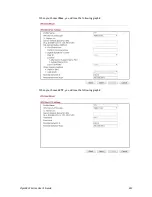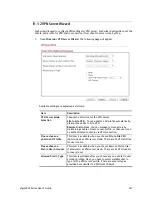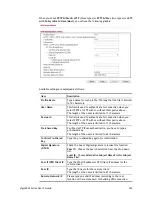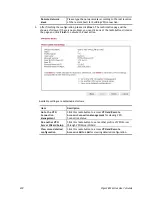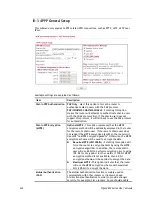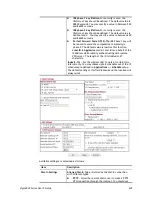
Vigor2832 Series User’s Guide
234
I
I
V
V
-
-
1
1
-
-
5
5
I
I
P
P
s
s
e
e
c
c
G
G
e
e
n
n
e
e
r
r
a
a
l
l
S
S
e
e
t
t
u
u
p
p
In IPsec General Setup, there are two major parts of configuration.
There are two phases of IPsec.
Phase 1: negotiation of IKE parameters including encryption, hash, Diffie-Hellman
parameter values, and lifetime to protect the following IKE exchange, authentication of
both peers using either a Pre-Shared Key or Digital Signature (x.509). The peer that
starts the negotiation proposes all its policies to the remote peer and then remote peer
tries to find a highest-priority match with its policies. Eventually to set up a secure
tunnel for IKE Phase 2.
Phase 2: negotiation IPsec security methods including Authentication Header (AH) or
Encapsulating Security Payload (ESP) for the following IKE exchange and mutual
examination of the secure tunnel establishment.
There are two encapsulation methods used in IPsec, Transport and Tunnel. The Transport
mode will add the AH/ESP payload and use original IP header to encapsulate the data payload
only. It can just apply to local packet, e.g., L2TP over IPsec. The Tunnel mode will not only
add the AH/ESP payload but also use a new IP header (Tunneled IP header) to encapsulate the
whole original IP packet.
Authentication Header (AH) provides data authentication and integrity for IP packets passed
between VPN peers. This is achieved by a keyed one-way hash function to the packet to
create a message digest. This digest will be put in the AH and transmitted along with packets.
On the receiving side, the peer will perform the same one-way hash on the packet and
compare the value with the one in the AH it receives.
Encapsulating Security Payload (ESP) is a security protocol that provides data confidentiality
and protection with optional authentication and replay detection service.
Available settings are explained as follows:
Item Description
IKE Authentication
Method
This usually applies to those are remote dial-in user or node
(LAN-to-LAN) which uses dynamic IP address and
IPsec-related VPN connections such as L2TP over IPsec and
IPsec tunnel. There are two methods offered by Vigor router
for you to authenticate the incoming data coming from
remote dial-in user, Certificate (X.509) and Pre-Shared
Содержание Vigor 3220 SERIES
Страница 1: ......
Страница 12: ......
Страница 62: ...Vigor2832 Series User s Guide 50 This page is left blank...
Страница 99: ...Vigor2832 Series User s Guide 87...
Страница 112: ...Vigor2832 Series User s Guide 100...
Страница 230: ...Vigor2832 Series User s Guide 218 This page is left blank...
Страница 319: ...Vigor2832 Series User s Guide 307...
Страница 363: ...Vigor2832 Series User s Guide 351...
Страница 403: ...Vigor2832 Series User s Guide 391 11 Click OK to save the settings The class rules for WAN1 are defined as shown below...
Страница 475: ...Vigor2832 Series User s Guide 463 This page is left blank...
Страница 499: ...Vigor2832 Series User s Guide 487...
Страница 506: ...Vigor2832 Series User s Guide 494...
Страница 510: ...Vigor2832 Series User s Guide 498...
Страница 512: ...Vigor2832 Series User s Guide 500 P Pa ar rt t I IX X D Dr ra ay yT Te ek k T To oo ol ls s...
Страница 517: ...Vigor2832 Series User s Guide 505 This page is left blank...
Страница 518: ...Vigor2832 Series User s Guide 506 P Pa ar rt t X X T Te el ln ne et t C Co om mm ma an nd ds s...
Страница 626: ...Vigor2832 Series User s Guide 614 show statistic reset wan1 Reset WAN1 tx rx Bytes to zero...




